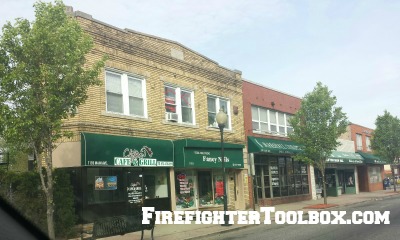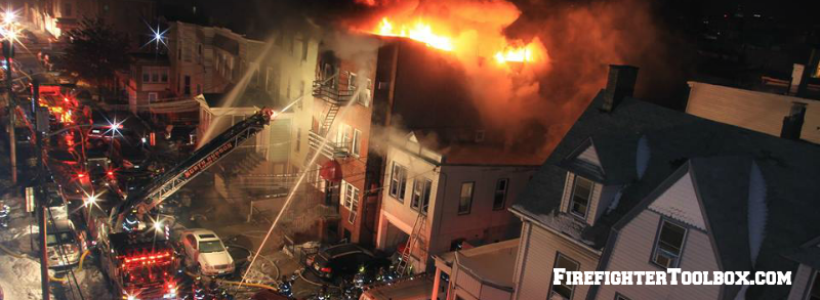3 Ways To Access The Roof Quickly – Part 1
How many options do we have to get to the roof of a Type 3 (ordinary construction) building? For most of us the answer is to the take the ladder or aerial device. The true answer is ALF.
Adjoining Buildings / Ladders / Fire Escapes
We will discuss 3 ways to access the roof, ranging from easiest to the most difficult and dangerous.
 #1 – Adjoining Buildings
#1 – Adjoining Buildings
Firefighters can gain access to the roof top of the fire building from an adjoining building. By climbing the attached building’s interior stairs, we are provided a safe and quick means to access the roof.
Upwind If Possible
One trick of the trade is to select the building that is on the upwind side of the fire building to gain access to the roof. The stairway in the upwind attached building usually will be free of smoke and will allow rapid ascension to the roof usually through a bulk head door. If your only option is to take the downwind building’s stairs, be prepared for lots of smoke and heat. Once on the roof, ensure that the bulkhead door that you just exited from does not close and lock behind you; this may be your primary means of egress if things go bad. If you encounter a heavy smoke condition and visibility is low, get down and crawl your way to the fire building. Use a tool to probe and sweep ahead to prevent yourself and your crew from falling into any air or light shafts. If you are approaching from the upwind side, visibility should usually be pretty clear.
Victims & The Bulkhead Door
As you approach the fire building, begin to assess the fire and roof conditions. After sounding the roof for its stability, immediately locate the bulkhead door on the roof of the fire building and open it. Search inside the stairs for any victims that may have mistakenly taken the stairs to try and escape the smoke and heat from the fire below them. If you have victims, remove them and notify command for assistance in getting them to the street. Use the same stairs that you did to facilitate the safe removal of the victims. Be sure to remove the bulkhead door completely or disable it from closing. Removal of the bulkhead door will allow for smoke and super-heated gases to escape the fire building and help to improve conditions for members operating inside the fire building.
Size-Up & CAN Report
Perform a 360 of the fire building from the roof. Look for any trapped victims on fire escapes or in windows, or victims that may have jumped prior to your arrival. Remember buildings can be deceiving from the A side look so be the eyes of the incident commander. Give a quick size up and CAN (Conditions/Actions/Needs) report to the IC.
Do Work & Get Down
Once your report is complete, locate the area directly over the fire (as much as possible) and prepare for vertical ventilation. Be sure to take the natural opening first then cut the roof remembering to working with our backs to our means of egress. Once your tasks have been completed, advise command of your progress and then get off the roof. This applies regardless of how you made the roof.
Secondary Egress
The attached building’s stairs will allow for the safe movement of manpower and equipment throughout the incident. Be sure to request a secondary mean of egress be placed to the roof as an added safety precaution. The use of adjoining building’s stairs is the safest and easiest method to access the roof. Stay safe!
Photos courtesy of James Wood, Sr. and John Hayowyk, Jr.
Check out the complete series here!
3 Ways To Access The Roof Quickly
Part 1: Adjoining Buildings
Part 2: Ladders (posting 8/25)
Part 3: Fire Escapes (posting (9/1)





